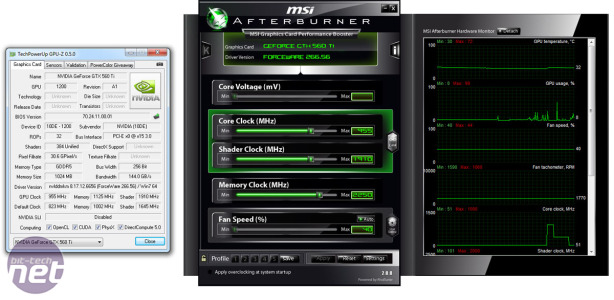
Overclocking
With the GTX 460’s fantastic overclocking pedigee, we had high hopes for the GTX 560 Ti 1GB when it came to ramping up the clock speeds, especially after our thermal testing indicated there was so much extra capacity for increased temperatures.For overclocking, we used MSI’s excellent Afterburner utility, increasing core and stream processor frequencies together in 10MHz and 20MHz increments respectively. As the GTX 560 Ti 1GB has Nvidia’s power overflow prevention circuitry, we used Just Cause 2 to test for stability, repeating the benchmark over and over while notching the clock speeds higher.
Our reference card didn’t disappoint, and with no adjustment to thefan speed and no additional cooling, we managed to push our card to a GPU core frequency of 955MHz, meaning that the stream processors were operating at 1,910MHz. We also managed to push the memory from 1GHz to 1.125GHz (4.5GHz effective). This equates to a GPU overclock of 16 per cent and a memory overclock of 13 per cent, and we saw improvements of this magnitude in the card’s performance in Just Cause 2.
Click to enlarge - The GTX 560 Ti 1GB overclocks very well indeed
Amazingly, this overclock even allowed the GTX 560 Ti 1GB to surpass a stock-speed GTX 570 1.3GB in some ganes, a remarkable outcome considering the £100 price gap between the two cards. Even massively pre-overclocked cards are likely to cost much less than a basic GTX 570 1.3GB, although we should point out that the GTX 570 1.3GB is itself very overclockable.
While overclocking didn’t impact the card’s idle power consumption or heat output (the card clocks itself down regardless), the power consumption of the card rose by 17W (or 6 per cent) to result in a total system power draw of 302W.
The peak temperature of the card also increased, from 37°C to 48°C, but the cooler remained very quiet throughout. With these levels of extra performance on tap, and with marginal thermal and power consumption detriments, there’s really no reason not to overclock your GTX 560 Ti 1GB.
The overclock we managed here is by no means uncommon either - a number of factory overclocked cards will be shipping at frequencies close to the ones we acheived. We also understand that some cards will have upgraded power delivery and even better cooling to allow GPU core speeds of 1GHz and 2GHz stream processors.

MSI MPG Velox 100R Chassis Review
October 14 2021 | 15:04









Want to comment? Please log in.